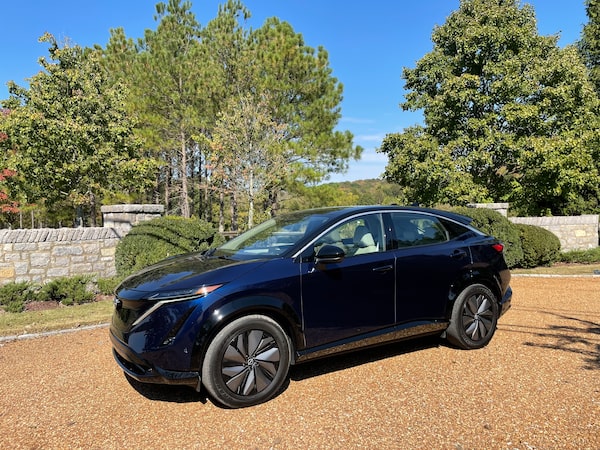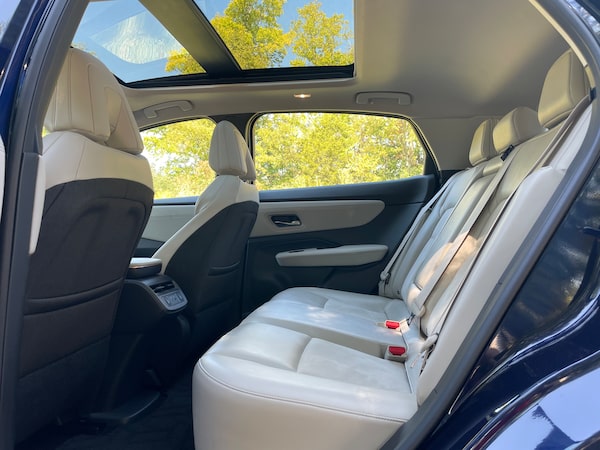
The 2023 Nissan Ariya.Petrina Gentile/The Globe and Mail
Nissan has a lot riding on its second all-electric vehicle, the Ariya compact crossover SUV. The Japanese automaker had a jump start on the competition with the Leaf, the world’s first mass-produced electric vehicle, in 2010. Since then, it has sold than 550,000 Leaf EVs globally, but the competition has also heated up. Now, Nissan appears to be shifting focus to the Ariya, which has more innovative technology, extra space, all-wheel-drive options and a starting price of $53,000.
The Ariya is part of Nissan’s Ambitious 2030 plan, which sets out a goal to expand its electrified portfolio with 20 products in the next five years, including 15 new battery-electric vehicles (BEV), and a target of more than 40 per cent BEV sales in North America by 2030.
The Ariya, a two-row five-passenger crossover, is built on a new EV platform. In Canada, it’ll be available in six models with front- or all-wheel-drive configurations, and a standard 66 kilowatt-hour battery or a longer-range 91 kilowatt-hour battery (63 or 87 kilowatt hours of useable battery capacity, respectively). Depending on the trim, the electric range varies from 328 to 482 kilometres, power ranges from 214 to 389 horsepower and torque from 221 to 442 lb-ft of torque.
My tester was a Empower+ pre-production model – in Canada, the equivalent model will be called Evolve+. It’s a front-wheel-drive trim with the bigger battery. Our route began in downtown Nashville with 486 kilometres of range and 100-per-cent battery charge displayed on the 12.3-inch instrument monitor. We made our way west toward Bowie Nature Park along a scenic route mixed with highway and winding parkways. This model has 238 horsepower and 221 lb-ft of torque, which doesn’t sound like much, but it’s enough juice to take on the twisty roads and merge onto the highways effortlessly. By the time we reach our lunch destination we’ve travelled 113 kilometres and have 78-per-cent battery with 387 kilometres of range remaining. We’ve managed to regenerate about 15 kilometres of electric range using the e-pedal – it allows the driver to accelerate or slow down by using only the accelerator pedal. But unlike other EVs, including the Leaf and Hyundai Ioniq 5, the system doesn’t come to a full stop, which I’ve grown to like because it reduces driver fatigue when driving in stop-and-go traffic.
Mid-day we tested a new system which can parallel and perpendicular park the vehicle – it’s the first Nissan to get the technology. Just hit a button and the system’s four around-view cameras and 12 ultrasonic sensors take over, looking for a suitable parking space. Once it’s found, hit “start” on the 12.3-inch centre screen and the vehicle will steer, shift the vehicle into reverse, accelerate, brake, park and even engage the emergency parking brake when complete. The driver doesn’t touch a pedal or the steering wheel. It worked on the first attempt, both parallel and perpendicular parking.
Inside, the cabin is minimalistic and clean with few traditional buttons – thankfully, there’s a volume dial. At times, it can be hard to find functions fast, but Nissan’s intelligent personal assistant helps. While it doesn’t understand natural language and is not as advanced as some other systems like Mercedes-Benz’s personal assistant, you can still ask it simple commands, such as “Hey Nissan, lower the temperature” and it’ll lower it by 1 or 2 degrees Celsius. It also has Amazon Alexa, wireless Apple CarPlay, wired Android Auto and over-the-air software updates. There’s also an adjustable centre console that moves forward and back. A fold-out tray table opens and closes below the centre screen.
By the end of the day, we travelled more than 210 kilometres. We arrive downtown with 285 kilometres of range remaining and 56 per cent of battery power. The driving range is fairly accurate and true to the real-life driving distance we covered.
The 2023 Nissan Ariya arrives in Canada later this year, starting with front-wheel-drive models; all-wheel-drive models arrive early next year. Prices range from $52,998 for the base Engage front-wheel-drive trim with the standard battery to $69,998 for the Premiere+ all-wheel-drive with the extended battery.

Nissan’s new design language is bold and modern with a rear spoiler, LED light bar, rear wiper blade and the Nissan name across the back.Petrina Gentile/The Globe and Mail
Tech specs
2023 Nissan Ariya
- Price: $52,998-$69,998
- Motors: Single (front-wheel drive) / dual (e-4ORCE all-wheel drive) electric motor
- Total battery capacity(useable) in kilowatt hours: – 66 (63) or 91 (87)
- Charging time: Level 2 (up to 7.2 kilowatts) – 10.5 – 14 hours; DC fast-charger (CCS standard up to 130 kilowatts) 20 – 80 per cent in 35-40 minutes; DC fast-charger (50 kilowatts) – 20 to 80 per cent in 65-90 minutes
- Horsepower/torque (lb-ft): 214 – 389 / 221 – 442
- Drive: Front-wheel drive or e-4ORCE all-wheel drive
- Claimed Range: 330-482 kilometres
- Alternatives: Volkswagen ID.4, Mustang Mach-E, Hyundai Ioniq 5, Kia EV6, Chevrolet Blazer EV
Looks
Nissan’s new design language is bold and modern with a solid, dark front end, slim LED headlamps, functional air vents and Nissan’s redesigned logo. There’s no front trunk, or frunk – instead the climate-control system has moved into that space. A rear spoiler, a LED light bar, rear wiper blade and the Nissan name appear across the rear. The back pillars are thick and large, at times obstructing rear visibility from the driver’s seat.

The Ariya boasts excellent head- and legroom thanks to a flat cabin floor.Petrina Gentile/The Globe and Mail
Interior
Minimalist and contemporary styling in the cabin with few traditional buttons or dials. Haptic capacitive-touch switches for climate control are integrated nicely into the wooden dash. Rear seats are suitable for three adults; they’re slightly reclined for extra comfort. Excellent head- and legroom thanks to a flat cabin floor, which houses the battery at the base of the chassis.

The cabin is minimalistic and clean with few traditional buttons.Petrina Gentile/The Globe and Mail
Performance
Off the line, it’s quick and has smooth, quiet and refined road manners. The “sport” driving mode tightens the steering and makes it more engaging to drive than “normal” or “eco” modes. Driving range is fairly accurate.
Technology
Nissan Safety Shield 360 is standard and includes six active safety features: automatic emergency braking with pedestrian detection, blind spot warning, rear cross traffic alert, lane departure warning, high beam assist and rear automatic braking. It also has ProPilot 2.0, the next-generation semi-automated driving technology.

The Ariya comes with 467 litres of trunk space; while the all-wheel-drive version has only 413 litres. There’s no front trunk.Petrina Gentile/The Globe and Mail
Cargo
The front-wheel-drive Ariya has 467 litres of trunk space; while the all-wheel-drive version has only 413 litres. While there’s no front trunk, the second-row seats fold flat for cargo space. There’s also a divide-and-hide cargo system for hiding precious items under the floor where it can’t be seen.
The verdict
The Ariya can hold its own against the growing competition. It’s a smart package with style, smooth driving manners, all-wheel-drive options and loads of impressive technology.
The writer was a guest of the automaker. Content was not subject to approval.
Shopping for a new car? Check out the new Globe Drive Build and Price Tool to see the latest discounts, rebates and rates on new cars, trucks and SUVs. Click here to get your price.